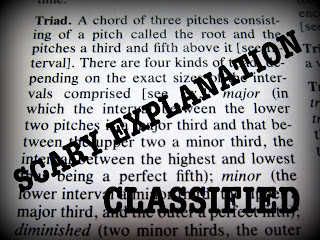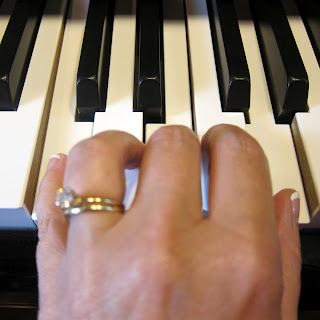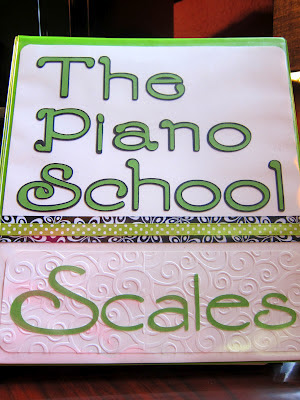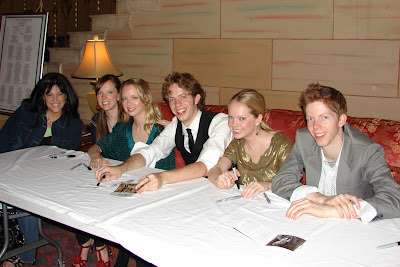I'd like to introduce you to my piano teachers. I've had several. Each one gave me at least one gift that really changed me as a pianist, and it is the culmination of these gifts that makes me the kind of teacher I am today. Here they are in chronological order.
DENNIS REASER
Years as my teacher: 1966-present
Lasting gift he gave me: a love of good, solid jazz piano
 |
| My dad was my first piano teacher. |
I grew up in a musical household. My parents are both very musically gifted, and my dad is a professional musician. He had begun his long career as a high school band director by the time I was born. Pretty much all of my happiest childhood recollections involve music at home, and I have so many memories of my dad playing jazz piano in the living room that they've sort of all merged together into one big jazzy heap. My dad taught me how to play "Chopsticks" as well as how to "vamp" on the piano while my sister and I sang our favorite songs. One "arrangement" that I still remember...exactly the way he taught me...is "Country Roads." It was a number I did in a talent show with my sister and two other friends in elementary school. Dad also taught me how to notate music. I composed a piano piece in 1976 for the bicentennial-themed PTA Reflections Contest at school. I also wrote the whole thing down on staff paper. There was some doubt at school about whether I'd done all of that on my own, and I had to prove it before a group of faculty one day! Ultimately, the piece won several levels of the Reflections contest...school, local, district, and fizzled out somewhere after that.
BONNIE TODENHOFT
Years as my teacher: 1972-1984
Lasting gift she gave me: Sightreading proficiency through the study of voluminous material
 |
Mrs. Todenhoft was my piano teacher from the time
I was seven until I graduated from high school. |
Mrs. Todenhoft was my first official piano teacher. I started my lessons with her when I was seven. The lessons were on Saturday mornings for an hour each week. I have to be totally honest with you and admit that I did not look forward to my lessons all the time. For one thing, I was a little kid and Mrs. Todenhoft was an older woman with a long list of college and adult piano students and a waiting list. She was way beyond me intellectually, and her amazing sense of humor was usually above my head. I didn't begin to appreciate all that she had to offer until I was older. Having said that, I LOVED hearing her play. She could play anything and everything. She could take requests. She read music like a whiz, but also played spectacularly by ear. Her piano was fabulous (a giant Yamaha grand), and whenever we played duets together, I was on cloud nine! It was a huge privilege to be her student, and even though I didn't always know exactly what I had, I did know that none of my friends had it. When I told people that Bonnie Todenhoft was my teacher, they were usually impressed. That was cool. Since my sister and I both had lessons on Saturday mornings for an hour each, we took turns going downstairs to her den and watching cartoons. The Todenhofts picked up channel 13 all the way from Lynchburg, and that meant one of us could watch "Schoolhouse Rock" and other wonderful shows that we didn't have at home while the other had her lesson.
Mrs. Todenhoft selected everything that I studied. There was no, "What would you like to work on this week?" It was always, "I want you to get started on this Kabalevsky Sonatina, and keep working on that Chopin Polonaise and those three Bach Inventions. Also, write out the C-sharp minor scale on staff paper, and go to the Roanoke College bookstore and buy this theory book. When you get it, try to finish a few chapters on your own." Get the idea? There was very little hand-holding, and absolutely no pop music. I was to do those things on my own. In the very early stages, she had me in the "Music Tree" method books and reading hymns straight from the hymnbook. The former was sort of cutting edge, and the latter was just plain hard!
The result of all of this was that I learned to read music really well. I became competent as an accompanist for the school and church choirs, and I was able to dazzle my friends by playing any piece of popular sheet music they wanted to hear. I was launched into adulthood with the ability to play pretty much anything I wanted, somewhat decently, without the help of a teacher. Which was good, because I stopped taking lessons for several years after high school.
MICHAEL SITTON
Years as my teacher: 2000-2005
Lasting gift he gave me: Performance Practice Know-How
 |
Dr. Sitton was my first piano teacher
after a long hiatus. |
When I was 33, I started piano lessons again. There had obviously been a long dry spell in that department since I left Mrs. Todenhoft at age 18. For my first lesson with Dr. Sitton, I was supposed to play some things for him. I brought in a list of possibilities, and from that he asked me to play "To a Wild Rose" by Edward McDowell and the Rachmaninoff Prelude in C-sharp Minor. I will never forget the first words out of his mouth after I nervously played those pieces. "You certainly have command of the instrument." Sort of made my day...and my next five years.
Studying with Dr. Sitton was not much like working with Mrs. Todenhoft. He did ask for input when it came to the selection of repertoire, and he was much more about fine-tuning and helping me learn to perform each piece in a way that was in keeping with its historical context. Today, I have to laugh at how shocked I was at the second lesson when I had "learned" the first movement of a Haydn Sonata and played it for him in a way that I thought was adequate. I was certain that we were going to move on to the next movement. But he started doing all of this "voicing" stuff and having me bring out the melody above the accompaniment. I had more work to do on articulating the ornaments correctly, and my left hand triplets weren't quite even. What the??? Welcome to performance study. It's not just about playing the right notes and the right rhythms. Dr. Sitton developed in me a sense of playing musically as well, and he was great at rounding out my repertoire, filling in gaps, and drilling all of the major and minor scales into my memory.
I learned so much about so many things from Dr. Sitton during the five years we worked together that I won't even attempt to summarize it all here. I will just say that many of the things my students are doing today stem from the time I studied with him.
ESTHER YOO
Years as my teacher: 2005-2006
Lasting gift she gave me: Work harder!
 |
| Esther Yoo was my teacher for one year. |
Enough pampering. Let's get serious here. Esther Yoo was the toughest teacher I ever had. She was a cute and bubbly sweetheart before and after my lessons, but she was a drill sergeant during. I cried during my first lesson. Here I was, awesome musician me. And there she was, unimpressed her. It was not smooth sailing in the beginning, but I will tell you this: she opened my eyes about my playing. It was not world-class. Not that I suspected it was. Dr. Yoo is the sort of teacher that you conjure up when you're thinking of 1920's Russia or something. She wanted perfection and competition-level quality. At least that's how it felt. Her technique was truly wonderful, and she wanted me to achieve new heights in my playing. I think I learned a great deal about touch and tone quality from her. I played more challenging repertoire than I had previously attempted, and I grew. It wasn't easy, but if I'm honest, I have to admit that she helped me.
REBECCA WALLENBORN
Years as my teacher: 2005-2007
Lasting gift she gave me: Playing with my heart
 |
Becky Wallenborn was my solo piano teacher
and duo piano coach for three years. |
Whew! After my year in boot camp, I went the complete opposite direction and worked with the world's most nurturing teacher. Becky Wallenborn is a pianist that feels every note she plays. The warmth of sound she produces can bring a tear to your eye. Her heart is enormous, and she has a passion for piano that few people do. When I worked with Becky, I learned plenty of technical goodies that have served me very well, but I think I mainly learned to open my heart up more. I found in her a teacher and a friend. She is someone who genuinely feels emotion when you play, and she tells you about it. I learned about "silent preparation" and using high fingers in practice from her. I learned crazy things like playing on my leg with one hand while playing expressive sound on the keys with the other. She was exactly what I needed at exactly the right time.
Of course, I gleaned way more from these wonderful musicians than I have written about here, but this brief exposé reveals a bit of the breadth of knowledge and experience that they passed down to me from their teachers, some of whom are rather legendary. I am truly grateful for each of them, and a day doesn't go by that I don't recall some comment, exchange, or revelation that was stamped on my brain at one of their pianos.

























.jpg)























